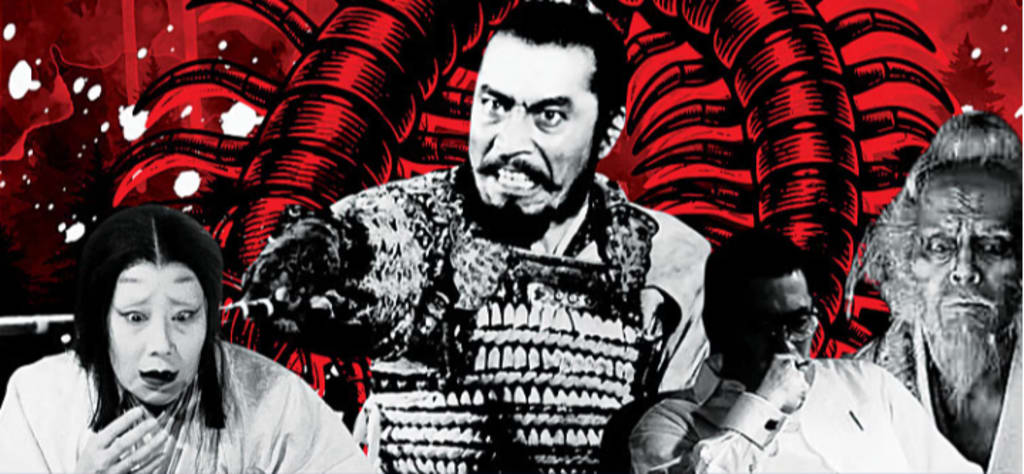Shakespeare's human impulses in Kurosawa's film
He Is Beyond Comparison..

Shakespeare's remarkable inventions of personalities have contributed to his enduring appeal on a global scale. The bulbous, comic Falstaff, the cruel Edmund and crueller Iago, the acceleratingly ambitious Macbeth and, of course, the charismatic Prince of Denmark himself—they stay relevant, unchanged in spirit through their journeys of translation, at least in the films and plays in South Asia that I am aware of. In Akira Kurosawa's three films based on Shakespeare plays, the Japanese maestro tones down this very remarkable aspect of Shakespeare. He plays around instead with the unforgettable emotions that the Bard's plays gift us.
When the generals Washizu and Miki (who represent Macbeth and Banquo, respectively) encounter an evil spirit who tells them what lies ahead for them and return to their Lord's castle to discover that the spirit's predictions are coming true, we can see a look of shock on their faces as they approach the camera in Kurosawa's Throne of Blood (1957). It's not just shock; it's shock with pleasure. A revelatory scene gave way to a terrifying scene as the actors approached them gradually. This isn't in the play; instead, Macbeth finds out that the first prophecy came true when a nobleman shows up to congratulate him on their win over Norway and Although it is a little invention, it gives the movie a feeling of mystery and fear. The second stab of this dread is given to the audience by Lady Asaji Washizu, Washizu's wife. Even though she lacks Lady Macbeth's commanding presence, the play's depiction of her shaking fingers as she tries to wash the "blood" off them is just as powerful.
I find it odd that Kurosawa chose not to include the character of Macduff in his adaptation of the Scottish play. Like many others, I believe that Macbeth is meaningless without Macduff, and Kurosawa's decision to omit his role is oddly provocative in that it separates Macbeth from one of the prophecies that ultimately leads to his demise.
However, Kurosawa is more interested in deconstructing the emotions of these ancient tales and refashioning them for the screen than he is in the storyline or the characters, as is seen in his second collaboration with Shakespeare, The Bad Sleep Well (1960). The Bad Sleep Well is a noir interpretation of Hamlet that is more of a marriage of conflicting passions: the son's desire to exact revenge on his father, the hot-headed brother's need to shield his sister, the paranoia about one's own sanity, the acting within acting, and the ghosts who appear to voice complaints. In many respects, Kurosawa's film embodies the ideal of a Hamlet adaptation: it is expansive, multifaceted, and concentrates on the essence of humanity rather than worldly troubles. Similar to how one hardly ever worries about Fortinbras' invasion in Hamlet, concerns about the company's bribes and unscrupulous kickback schemes are merely background noise in The Bad Sleep Well. The spectator is deeply shaken by the protagonists' trampled life and the outpouring of their complaints.
Kurosawa's third Shakespearean film, Ran, was released in 1985, more than two decades later. It is among his greatest accomplishments and is based on King Lear. The film transcends beyond just a simple war epic, as its violence and people' feelings of humiliation, envy, and wickedness are so masterfully crafted. Shakespeare's translations into many other languages are like vessels. When the clothes and pistols are put away, Romeo and Juliet (1996)—the punk mafioso Romeo and Juliet—remains. One might easily extract a bland Hamlet from The Lion King (1994). Despite its brilliance, I would even concede that Throne of Blood is really a vessel from which the "real" Macbeth can be removed with ease. With Ran, that is not feasible. One cannot even begin to comprehend how Kurosawa was able to create something so unique and yet so entwined with King Lear.
I will admit that I was never impressed by Edmund, King Lear's main enemy. He is not Iago. However, Kurosawa resurrects him in Ran as Lady Kaede, the eldest son's wife. Edmund at last finds a personality that makes sense in Lady Kaede. In fact, Lady Kaede's brutality is a masterpiece of film. It's obvious that Kurosawa's King Lear is a man's world. The three sons of the aging warrior Hidetora are transformed from the three daughters of King Lear. But in all of the Kingdoms' bloodshed and carnage—or maybe precisely because of it—it is Lady Kaede who shines brightest.
Shakespeare's three great tragedies adapted by Akira Kurosawa will endure, notably Ran. The movies honor the human passions, which are what really made Shakespeare great. The frantic, destructive ambition of Washizu in the role of Macbeth, the suppressed wrath of Koichi Nishi in the role of Hamlet, and Lady Kaede's disorganized schemes of violence and seduction in the role of Edmund. I often ponder what Othello, the bard's fourth great tragedy, might have looked like in a Kurosawa film. on example, how would he have created Iago on the screen? It was comforting to know that Kurosawa would never serve us Shakespeare room temperature, no matter what he did.
About the Creator
Wayne Limon
Wayne Limon was born in North Augusta, South Carolina. Graduated with a Master's Degree in English Language and Literature. Loves to read books. This love inspired him to write books later. His writing is witty and thought provoking.
Enjoyed the story? Support the Creator.
Subscribe for free to receive all their stories in your feed. You could also pledge your support or give them a one-off tip, letting them know you appreciate their work.






Comments (1)
Wow! You know you plays...I was really bad at reading stories in play form, I can imagine them being done in the beautiful dress style of Asia though, must be lovely. Very interesting article.